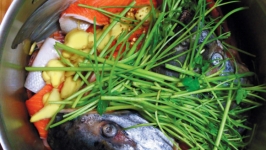The Bloody Picnic Table
It’s dark outside. Then again, it is summer in Alaska, and it never truly gets dark. So, maybe this is one area where the memory is different from the true event. In my memory it is dark. This may not have been the case; I haven’t asked my dad.
I am seven years old, hanging over the back of a beat-up royal blue couch, looking out the window. The trailers here are evenly spaced apart, each lot the exact same size. Cookie cutter, although each house and family here are banged up in their own unique ways.
The space between my parents’ trailer and my uncle’s is our fish camp. At least, that is what it is quickly converted into once the men in my family pull up with their catch. The picnic table, which is normally where I play dinosaurs, has a clear plastic tarp tossed over it. The fish are laid out on it, ready to be cut and processed.
The men work fast as I watch. I am not allowed to touch the enormous knives that they use to slice each fillet. The sharp end neatly slides under bone, which is pulled and set aside. There is a ritual to it, an assembly- line kind of motion that must be tedious to perform, but is oddly satisfying to watch. Even at seven years old, I appreciate the repetition.
As they cut, blood and ocean water run down that clear tarp, all the way to the grass. There it pools in frothy pits of pink, a piece of the Kenai seeping into Anchorage soil.
We are not normally these kinds of Natives. My father calls us “city Natives.” He tells us stories about growing up in the village, and a life filled with hunting and gathering. They sound like fairy tales to me, a child who gets on a school bus every day and eats McDonald’s for dinner. So no, we are not that kind of Native—not even close.
But today we are. Today the fish come in, and everyone gathers around the bloody picnic table. My father cuts off fish heads and turns them into puppets and we kids squeal as he threatens to chase us with them. Later, in college, a girl from Kodiak would tell me a similar story of her father back home, fish heads and all. We’d laugh and I would think, “Huh, so this is what Dad was talking about.”
But for now I am seven, and all I see is the red of the fish, impossibly bright, the kind of color that grocery chains wish they could achieve through food dye, but always fall short. Our fish are sliced, vacuum-packed, and sent to the freezer. The tarp is cleared away. The blood and ocean water have been absorbed by the lawn.
My father wakes up the next day and goes to work, his usual nine to five. He is clean-shaven now, the scruffiness from his weekend gone completely. We go to school, where we sort of look the same as everyone else—white, at least on the surface, everything else hidden underneath.
I don’t remember eating the fish. In fact, I don’t recall ever seeing it again.












